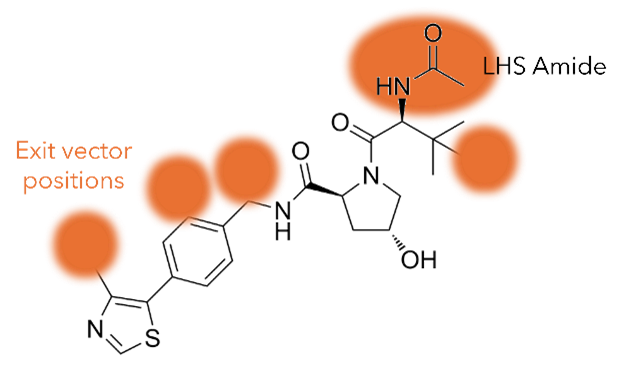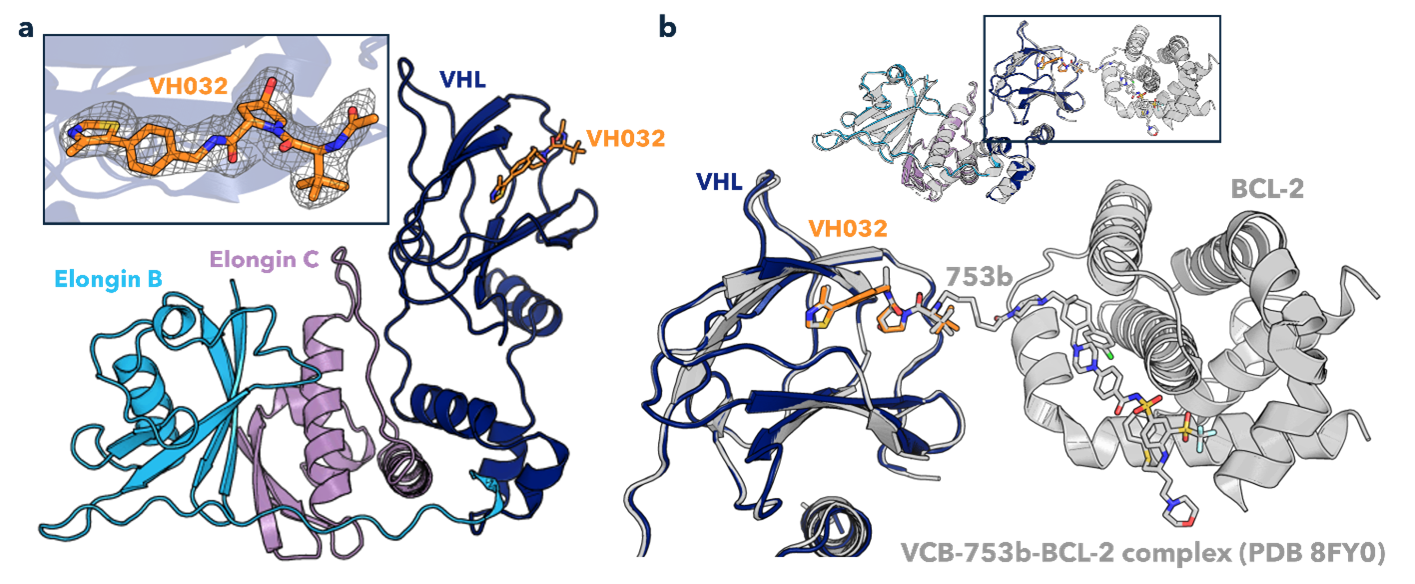Targeted protein degradation: insights into a VHL-compound structure
Introduction
Targeted protein degradation (TPD) is an emerging therapeutic strategy that hijacks the cell’s ubiquitin–proteasome system to selectively degrade proteins. In this process, ubiquitin tags are attached to lysine residues on target proteins, marking them for destruction. A key player in this cascade is the E3 ligase, which recognizes substrates, polyubiquitinates them, and directs them to the proteasome.
This mechanism can be exploited using bifunctional molecules called proteolysis-targeting chimeras (PROTACs). These molecules simultaneously bind an E3 ligase and a target protein, connected by a linker. Humans have over 600 E3 ligases, but VHL (von Hippel–Lindau) and Cereblon are the most widely used due to their well-characterized binding sites.
At Sygnature Discovery, we have already established production of both VHL and Cereblon which are active in SPR. With VHL-ligand-based PROTACs rapidly advancing—frontrunners now in Phase III trials—the field is full of potential to develop novel therapies across diverse targets. In this blog, we showcase how leveraging our expertise in functional VHL protein production has propelled us to go a step further in TPD.
Structural insights for rational PROTAC design
Within a PROTAC, the binding moieties for the E3 ligase and target protein are critical for substrate recognition, but the linker is equally important. It determines the spatial arrangement and flexibility between the two complexes, ensuring lysine residues remain accessible for polyubiquitination. The linker also influences the PROTAC’s physicochemical and pharmacokinetic properties.
Structural data from ternary complexes (E3 ligase–PROTAC–target) provide valuable mechanistic insights that can guide iterative design for improved efficacy. Similarly, structures of binary complexes (PROTAC bound to either the E3 ligase or target) help optimize binding interactions and linker positioning.
VHL and the VCB complex: A widely used tool
VHL functions within a multi-subunit complex that recruits substrates such as hypoxia-inducible factor (HIF) for ubiquitination and degradation. Together with adaptor proteins Elongin B and Elongin C, VHL forms the VCB complex, a minimal yet powerful tool for TPD development.
Following the determination of the VCB–HIF structure in 2002, significant efforts focused on designing small molecules that mimic HIF’s binding interface on VHL. Among these, the VH032 scaffold, particularly with a left-hand-side (LHS) amide exit vector, remains the most widely used VHL-binding moiety in degrader development (Figure 1).

Figure 1. VH032 scaffold with different exit vector positions.
Structure determination of VCB-VH032 complex
Building upon our expertise in production of highly active, homogenous VCB complex in-house, our team successfully determined the X-ray crystal structure of the VCB complex bound to the tool compound VH032 at 2.3 Å resolution (Figure 2a). The heterotrimeric VCB complex crystallized under conditions optimized from literature and broad screening. The resulting crystals contained two heterotrimers per asymmetric unit, each with VH032 bound to VHL.

Figure 2. Structure of VCB-VH032 complex.
(a) Our in-house structure showing VHL (blue), Elongin C (purple), Elongin B (cyan), and VH032 (orange). (b) Overlay with VCB–753b–BCL-2 complex (PDB 8FY0) reveals excellent alignment of VCB and the VH032 scaffold.
A comparison of our in-house VCB-VH032 structure with a published crystal structure of VCB bound to a VH032-based PROTAC in complex with BCL-2 shows excellent superimposition (Figure 2b). This not only confirms the integrity of our VCB complex but also allows us to test the DMSO tolerance of crystals- opening avenues for soaking or co-crystallization with additional ligands.
How Sygnature can help your degrader projects
At Sygnature, we’re committed to accelerating your success in TPD—delivering solutions that are rapid, reliable, and consistently reproducible. Services offered include:
1. Protein services: production of highly active, purified VCB and Cereblon complexes.
2. Structure determination services: high-resolution structure determination of VCB-ligand complexes.
3. Full drug discovery package services: includes close integration with our biophysics team to find lead compounds, study degrader interactions and the potential of the CHARMED platform to deliver rapid synthesis, screening and characterisation of bifunctional lead compounds from existing binders.
If you would like to learn more about our protein services or other services, please get in touch.


